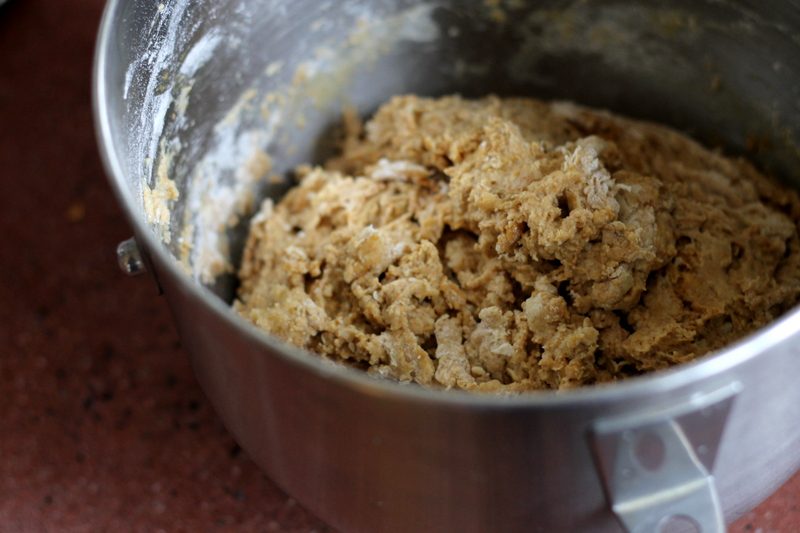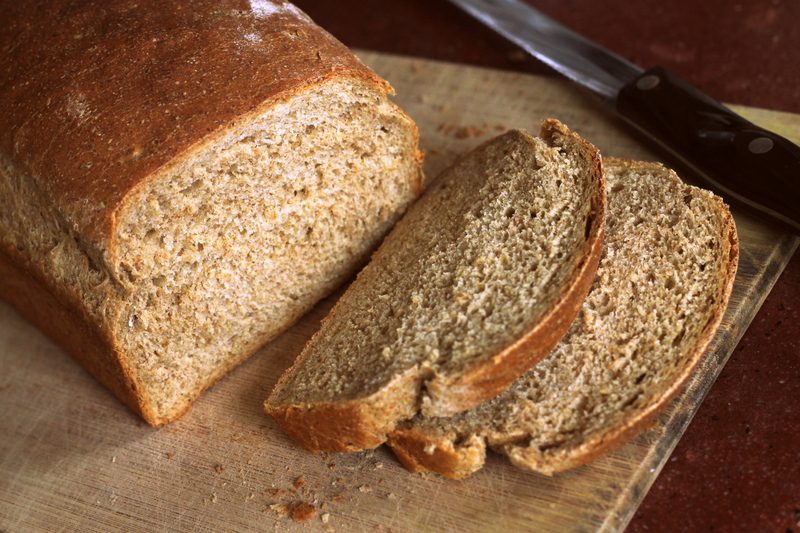It is after five p.m., the sky is darkening, and I’m sitting on the sofa in front of the fire where I’ve spent most of the day sleeping. I don’t feel awfully sick, but it’s not like me to sleep off and on until mid-afternoon so I guess I am. I did rally enough to clean out the bathroom cabinets, which is totally not my sort of thing, thus making me wonder if my condition is more dire than I first thought.
Mid (one of my many) nap, the neighbor woman stopped by with a basket of grapefruits and oranges. She didn’t know I was sick, and I didn’t even go talk to her—she was gone before I could heave open my eyelids—but all that citrus generosity made me buzzy happy and eventually I toddled out to the kitchen to eat one of each. And then I ate graham crackers, cleaned off the art table, and picked up my (coughing, oh dear) daughter from work. In keeping with my random, sick-girl behavior, I just ate a bowl of potato chips and now I want to tell you about bread, so humor me, please.
We eat sourdough bread most of the time in this here house, but every now and then I get a hankering for fresh bread the easy peasy, commercial yeasty way. So a couple weeks back when I had whole grains on my mind and a large sack of hard red spring wheat in the pantry, I did some old-fashioned recipe perusal and then settled on an oatmeal sandwich bread from Kim Boyce’s fabulous book, Good to the Grain.
It was neither the “oatmeal” part nor the “sandwich” part of the recipe that intrigued me, but rather the recipe’s straightforward method and the bread’s dark golden hue. It looked perfectly wheat-y and whole grainy, exactly the brown bread I was after. So I made it and fell, as is my custom with good recipes and delicious food, madly in love.


The recipe was a breeze to work with (especially when enlisting a Kitchen Aid) and I learned all about autolyse, which is the delightful and profound process of allowing the ingredients to rest before adding the salt and kneading. Autolyse(ing?) allows for the grains to absorb more of the liquid so the bread stays more moist. And boy, does it ever! The bread was angel cloud, meltingly soft. I was S.O.L.D. sold.

And then, rather by happenstance, I ended up using the fresh bread to make sandwiches—we were running errands or going to the theater or something, so I rustled up a ham salad and slapped together some sandwiches—and then I totally understood why the bread was classified as sandwich material.

The bread was so tender and soft that it melded to the filling. Sometimes you want a sturdy sandwich bread to stand up to the filling—that’s the way of sourdough—but other times you want a bread that is a bit more comfortable with sharing its space, more accommodating towards textures and flavors, and this, my friends, this is that bread.

PS. I wrote this post on Thursday. On Friday I felt like a million dollars and made an entire turkey dinner to celebrate. On Saturday, I didn’t feel quite as hot but still managed to muster enough energy to make a batch of this bread. For the requisite turkey sandwiches, of course.

Oatmeal Sandwich Bread
Adapted from Good to the Grain by Kim Boyce.
This recipe is supposed to yield one loaf but I made two. My pans were on the large side so I worried that the loaves would be too skimpy. Turns out, the dough rises well so the loaves shaped up quite nicely (though slightly on the small side).
1 tablespoon yeast
3 tablespoon molasses
2½ cups whole wheat bread flour
2 cups bread flour
1 cup rolled oats
½ stick (4 tablespoons) butter, melted
1 tablespoon salt
In a large mixing bowl (or in the bowl of your stand mixer), measure 2 cups of warm water, the yeast, and molasses. Stir briefly and let sit for five minutes until bubbly. Measure in the flours, oats, and melted butter. Mix until just combined. Now, autolyse! In other words, cover the bowl with a towel and let sit for 30 minute. So complicated, I know.
After thirty minutes is up, the dough should be ragged and poofy. Add the salt and mix for 4-6 minutes. The dough will be quite soft and slightly sticky, so, if mixing by hand, you’ll get a workout. (If kneading by hand, be extremely sparing with the flour.) Place the dough into a greased bowl and cover with plastic. Let rise until double, about 30-60 minutes.
Turn the dough out onto a floured surface and divide it into two parts. Shape into loaves and place into greased loaf pans. Cover and let rise until doubled.
Bake the loaves at 400 degrees for about 30-40 minutes, rotating the loaves partway through. Remove the loaves from the pans and let cool before slicing. Make sandwiches!
This same time, years previous: nanny sitting, the college conundrum, in my kitchen: 6:44 p.m., sushi!!!, cinnamon raisin bread, the quotidian (12.3.12), baked ziti, 17 needles and 4 children, the quotidian (12.5.11), red lentil coconut curry, and wild.



9 Comments
Zoë
You salt your hotdogs, SK?!
About to stick this bread in the oven. I'm excited.
sk
Maybe too much salt? (For Rhona–she tried this bread.) But she loved it anyway.
Jennifer Jo
We never thought twice about the salt, so it wasn't a problem for us. (And for you, the woman who salts her hot dogs, I'm surprised you'd think so!) If you're sensitive, just go skimpy.
Melodie Davis
Would you say this bread is better than More with Less Oatmeal bread?? If so, I'll have to give it a try. That's my go to of course.
Jennifer Jo
Oatmeal bread from More With Less was our special treat bread when I was growing up—I LOVE that bread. This bread is similar, I suppose, but more whole grain-ish and a little less desserty than that oatmeal bread, though it still manages to be ridiculously tender and sweet. You'll have to give it a go and let me know what you think!
Suburban Correspondent
Very intriguing. So the trick is simply to add the salt last, after it rests? I wonder why?
Jennifer Jo
Roughly speaking (because I'm no expert), autolyse is the process of breaking down the flour cells (specifically, the protein and starch). This results in the better production of gluten. The addition of salt inhibits that process. Salt can also damage the yeast. So by adding the yeast to the flour and water ahead of time (though true autolyse is simply the combination of flour and water, no yeast or salt), the risk of the salt damaging the yeast is decreased.
Becky
We're mostly sourdough too, with breaks taken for rye. I'm totally trying this.
Margo
I do that resting period, but I didn't know its name! We are like you – sourdough most of the time with the odd loaf of commercial yeast thrown in. My family adores oatmeal bread.